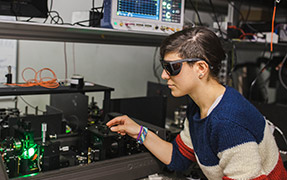SPIE President David Andrews’ doctoral theory is key to new chiral-nanoparticles discovery

Over 40 years ago, as a young doctoral student, current SPIE President David Andrews theorised that the chirality of nanoparticles could be observed through even harmonics of light. Until two years ago, this theory was not proved experimentally: at that time, physicists at the University of Bath devised a method to confirm Andrews' proposal and observe previously hidden twists in nanoparticles. The same researchers have now discovered these effects can be observed through the odd harmonics of light as well. These interactions between photonics and the twisted materials, as detailed in "Optical Activity in Third-Harmonic Rayleigh Scattering: A New Route for Measuring Chirality," have implications for emerging nanotechnologies in communications, nanorobotics, next-generation bio- and nanomachinery, and ultra-thin optical components.
The latest breakthrough was made possible by illuminating twisted (chiral) nanoparticles with ultra-short, near-infrared laser pulses and detecting the emission of ultraviolet photons, at precisely one third of the illumination wavelength. The new method allows researchers to study nanoparticles' twists more comprehensively: the newly observed effect is present in the propellers for nanorobots and can affect the direction of propagation for a laser beam. It is also applicable in tiny volumes of illumination, suitable for the analysis of natural chemical products that are promising for new pharmaceuticals where available material is often scarce.
"From a practical point of view, our results offer a straightforward, user-friendly experimental method to achieve an unprecedented understanding of the interactions between light and twisted materials," says Director of Research of the Department of Physics University of Bath Professor Ventsislav Valev, one of the paper's authors. "Such interactions are at the heart of emerging nanotechnologies. To take a musical analogy, until now, scientists who study twisted molecules — such as DNA, amino acids, proteins, and sugars — and nanoparticles in water, have illuminated them at a given frequency and have either observed that same frequency or its noise, known as ‘inharmonic partial overtones.' Our research opens up the study of the harmonic signatures of these twisted molecules, so that we can appreciate their ‘timbre' for the first time."
"When I first worked up this theory, it was by done by exploiting some mathematical results which I had first derived during my PhD studies and only recently published," notes Andrews, now a professor of chemical physics at the University of East Anglia who leads the university's nanophotonics and quantum electrodynamics research group. "At the time, no one else had yet applied them. The application seemed obscure, and I was not surprised that its publication received rather little notice. I knew the experiments would be difficult; there were not even that many commercial lasers around, though the rapidly accelerating performance of new systems gave me a smidgeon of hope. Many decades later, it came as a sudden and enormously welcome surprise to find that Professor Valev's team had secured some very exciting preliminary results whose validation led to today's publication. And now we recognize the scope for some powerful applications of the new experimental method, way beyond my imagination all those years ago. All credit to the experimentalists for pursuing such an elusive goal."
| Enjoy this article? Get similar news in your inbox |
|



